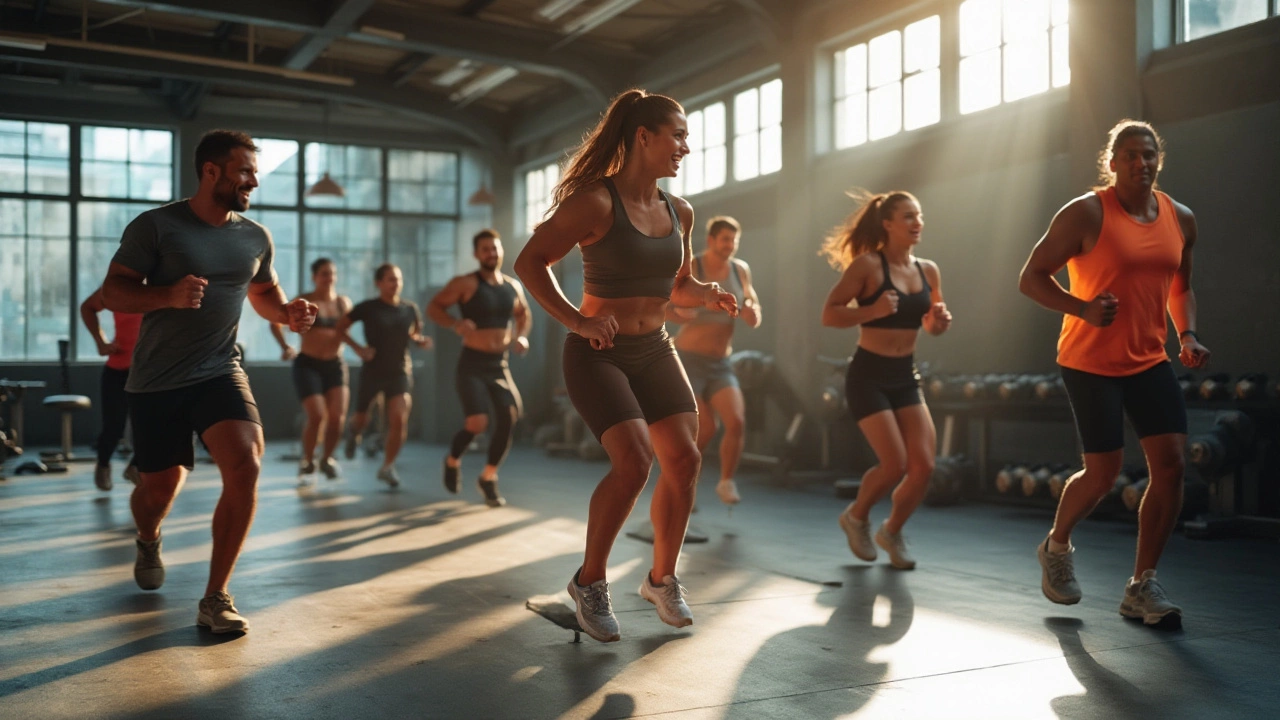
High-Intensity Interval Training, more commonly known as HIIT, is like that peculiar magic trick runners talk about: short, intense bursts that not only spike your heart rate but also promise to burn fat efficiently. Imagine being able to carve out just half an hour from your day and emerge with results you'd typically spend double the time to achieve on a treadmill. It sounds like a dream, but many fitness enthusiasts swear by it.
With January's resolutions still fresh in many minds, the question on everyone's lips is whether 30 minutes of HIIT is genuinely enough to lose weight. The answer isn't just a matter of yes or no—it's more about how this powerhouse workout affects your body and metabolism.
Let's unravel the layers of HIIT, understand how our body responds to such workouts, and how you can harness its power to get the most out of each session. By the end, you might find yourself lacing up your sneakers, ready to embrace HIIT with newfound enthusiasm.
High-Intensity Interval Training, known far and wide as HIIT, isn't just another buzzword in the vast ocean of the fitness world. It's a transformative approach that strips away the fat, not just off your body but also off your workout routine. At its core, HIIT combines frenzied bursts of powerful activity with short, sometimes active, recovery periods. This dual nature acts like an accelerator pedal for your heart rate, launching it into the cardio zone where the magic of calorie-burning truly begins.
One of the most captivating aspects of HIIT is how it tailors itself to both the novice and the experienced athlete, offering the flexibility to intensify or moderate the workout based on personal comfort levels. This adaptability can be traced back to its origins in the late 20th century when sports scientists were desperately hunting for an edge in athletic training. An iconic study from the 1990s, led by Izumi Tabata, unfurled the curtain on HIIT's effectiveness—comparison between moderate-intensity continuous training and a novel high-intensity regimen unveiled HIIT's superiority in improving both aerobic and anaerobic pathways.
HIIT's unique structure doesn’t just help in shedding stubborn pounds; it's renowned for boosting cardiovascular health and improving metabolic functioning. During those frantic intervals, your body's demand for oxygen surges, leading to an increase in something called post-exercise oxygen consumption (EPOC). This mechanism ensures your body continues to torch calories even hours after you’ve kicked off those sneakers and called it a day. In fact, if there’s one reason HIIT has gained a stellar reputation, it’s this afterburn effect. A HIIT workout may seem short-lived, but the calorie-burning benefits are profoundly lasting.
If there's still skepticism about whether this technique holds water, consider the words from Martin Gibala, a prominent physiologist:
"Time tends to be the number one barrier to exercise," says Gibala, adding that a HIIT routine can provide many favorable adaptations typically associated with traditional endurance training in a fraction of the time.This testament solidifies the notion that HIIT isn’t just efficient; it’s revolutionary.
For those data enthusiasts out there, here's a little nugget:
| Type of Activity | Calories Burnt in 30 mins |
|---|---|
| Traditional Cardio | 200-250 |
| HIIT Session | 400-600 |

When it comes to squeezing the most benefits out of limited time, a 30-minute HIIT session is a game-changer. It’s not just about fitting a workout into a jam-packed schedule; it's about maximizing output in a minimal timeframe. The magic of short, intense bursts of activity lies in its ability to hurl your body into an “afterburn” state, known scientifically as Excess Post-exercise Oxygen Consumption (EPOC). This condition helps you continue burning calories even after you've finished working out. Imagine going about your day while still torching calories from your morning HIIT session — sounds appealing, doesn’t it?
Beyond calorie burn, HIIT workouts have been shown to improve cardiovascular health by increasing heart rate variability and enhancing your overall metabolic function. These changes can significantly impact your health by reducing risks related to heart diseases. For those wary of long, monotonous gym sessions, HIIT offers an exciting alternative where time seems to fly by as you switch between high-intensity exercises and brief rest periods. It's a routine that shuns monotony, keeping your workouts fresh and engaging.
Moreover, let's not forget the psychological benefits. Engaging in a consistently challenging regimen can enhance mental resilience and boost endorphin levels, leaving you feeling more energetic and happier daily. The short duration of 30-minute workouts means you're more likely to maintain regularity, which is key in developing a strong fitness habit. Maintenance of muscle mass is another hidden perk. While traditional cardio exercises can sometimes lead to muscle loss, HIIT fosters muscle retention even as you focus on losing weight. This mix of fat loss and muscle retention helps redefine your body composition, giving you a leaner and more toned look.
"HIIT workouts are so effective because they engage the aerobic and anaerobic systems simultaneously," explains Dr. Jordan Smith, a leading fitness researcher. This dual engagement ensures cardiovascular health improvements while also allowing effective weight management strategies.
The magic doesn't stop with muscle retention. Some studies have shown that HIIT can even boost metabolism and increase how fast body fat is burned, truly positioning it as an efficient weight loss method. It’s personalized, too. HIIT can be adapted to different fitness levels, allowing anyone from beginners to advanced athletes to tailor it to suit their personal goals and limits. With such workouts, it's not rare to see people achieve their fitness goals and touch that healthy weight zone in a comforting time frame. Nutrition, hydration and rest, however, should go hand-in-hand with workout plans for optimum results.
For many busy bees, time is of the essence, and 30-minute HIIT sessions let you slip in a heart-pumping workout without sacrificing your day’s obligations. As people have adapted to new normal work-life dynamics, finding time for extensive exercise routines seemed daunting, yet these quick workouts fit seamlessly into virtually anyone's schedule. Make every minute count, and soon enough, a healthier, fitter version of you might just become your reality. Who knew you could achieve so much with such a brief daily commitment?

The intrigue surrounding HIIT workouts often circles back to their unique ability to maximize caloric burn in minimal time. Weight loss, essentially, boils down to creating a calorie deficit, where you're expending more calories than you're consuming. HIIT is renowned for this as it ramps up your metabolic rate and keeps it elevated even after the workout. This phenomenon, known as excess post-exercise oxygen consumption (EPOC), means your body continues to burn calories at a higher rate for hours post-exercise.
A study published in the Journal of Obesity highlights that a mere 15-minute HIIT workout can result in calorie burn akin to what you'd achieve after a 45-minute jog due to EPOC. Dr. Martin Gibala, a leading scientist in the field of exercise physiology, stated,
"The secret of HIIT lies in its ability to produce many of the benefits of prolonged endurance training in a much shorter duration."It's the kind of workout that challenges every fiber of your body, engaging multiple muscle groups simultaneously, which directly translates to more calories burned in less time.
Research from the American Council on Exercise suggests that during a workout session, your body shifts between aerobic and anaerobic states. In anaerobic conditions, the body relies on stored energy in the muscles, lending itself to muscle growth and fat reduction. The beauty of HIIT is that it leverages both states, promoting fat oxidation unlike any other workout. Additionally, data from a 2021 survey performed by the National Institutes of Health indicates a 29% increase in weight loss among participants who incorporated daily HIIT sessions compared to those who opted for steady-state cardio.
But there's more. A deeper delve into the science of weight loss reveals that the hormonal benefits of HIIT are not to be underestimated. A surge in hormones such as adrenaline and noradrenaline during these workouts accelerates fat release from visceral fat stores, which are commonly associated with weight gain and metabolic disorders. Aiding in this process is the production of lactate, a byproduct of intense physical exertion, which ironically plays a role in improving overall metabolism.
From a practical standpoint, achieving results hinges on several factors including workout intensity, frequency, and diet. The metabolic demands of HIIT mean that nutrition becomes paramount; balanced intake of macronutrients supports energy levels and recovery. Thus, intertwining fitness tips with a calculated approach to calorie intake ensures not only weight loss but sustainable health improvements.

Embarking on a HIIT workout routine can be as thrilling as opening a new chapter towards achieving your fitness goals. But like any journey, this too requires the right strategy for success. First and foremost, let's address the aspect of intensity. The beauty of HIIT lies in its ability to push your limits; however, it's essential to listen to your body's cues. A grueling session isn't synonymous with effective exercise if it leads to exhaustion or injury. Instead, aim for a balanced level of intensity where you're challenged but not overwhelmed, particularly if you're new to high-intensity workouts.
Another secret weapon in maximizing your 30-minute HIIT sessions is variety. Repetition can be the nemesis of motivation. Incorporating a variety of exercises not only keeps things fresh but engages multiple muscle groups. You could alternate between classic jump squats, powerful burpees, and invigorating mountain climbers. Consider the rhythm and flow of your workout and how different exercises fit together. You’ll find that structuring them smartly will significantly enhance your efficiency.
Timing is a critical factor that greatly influences the effectiveness of a 30-minute workout. The intervals of high intensity should be followed by periods of rest or low-intensity activity. Experiment with different intervals to discover what suits you best. Some may prefer a 30-second high-intensity burst followed by a 30-second rest, while others might find tabata-style or pyramid routines more beneficial. As you become more comfortable with the methods, you can tweak the timing to keep it challenging.
"The best workout is the one that you actually do. So consistency is key," says renowned fitness trainer Jillian Michaels. True effectiveness lies in the regularity of your routines. Dedicating those 30 minutes as a part of your daily or weekly schedule will ensure gradual, sustainable progress.
Lastly, tracking results can be a tremendous motivator. Whether it's a journal or a fitness app, keeping record of your performance allows you to spot improvements over time—be it in the form of enhanced stamina, increased calorie burn, or simply feeling more energetic. This data-driven approach can be inspiring and affirm your commitment to your weight loss journey.
Not to forget the importance of hydration and nutrition. You’ll need to refuel your body adequately to maintain the energy levels required for intense sessions. An adequate protein intake, along with a balanced mix of carbohydrates and healthy fats, will support muscle recovery and growth. Armed with these strategies, you’ll be well on your way to harnessing the full power of HIIT and reaping the benefits it offers—fitter, healthier, happier.